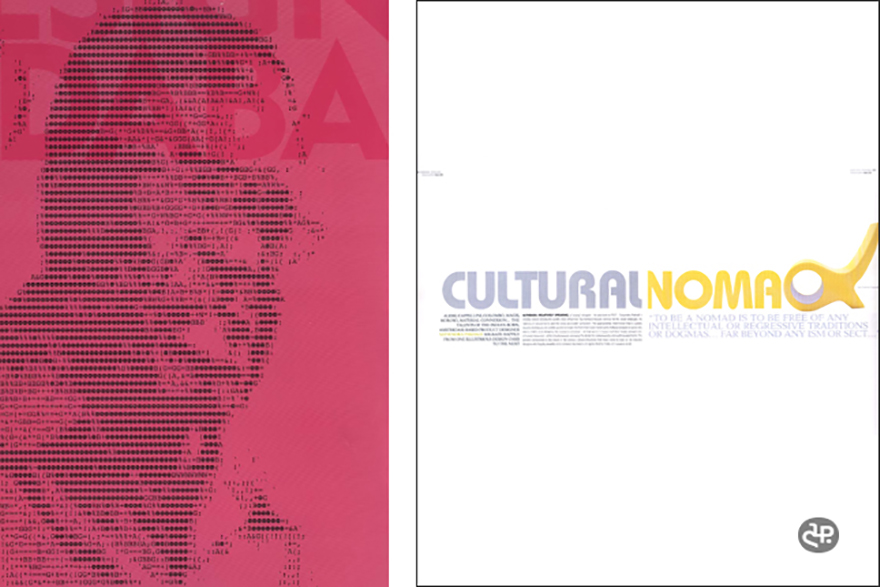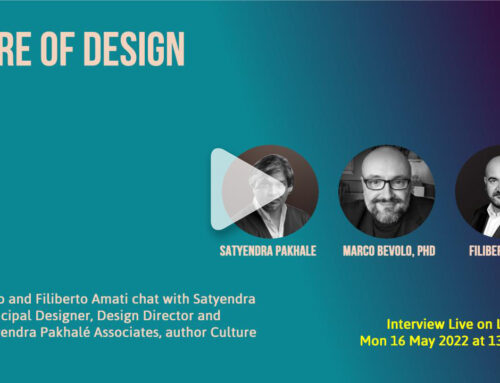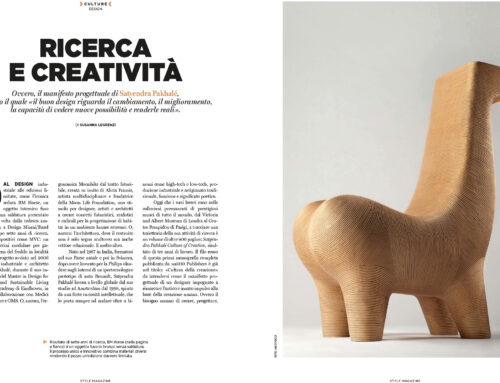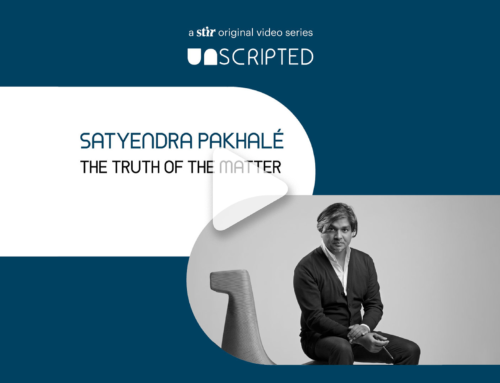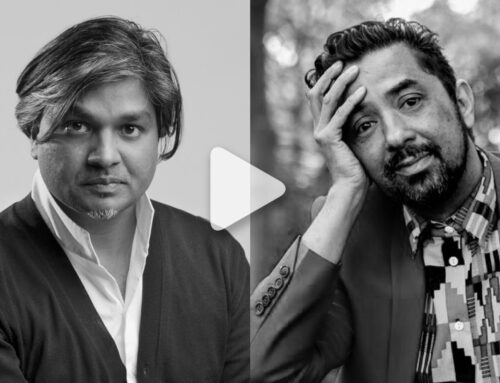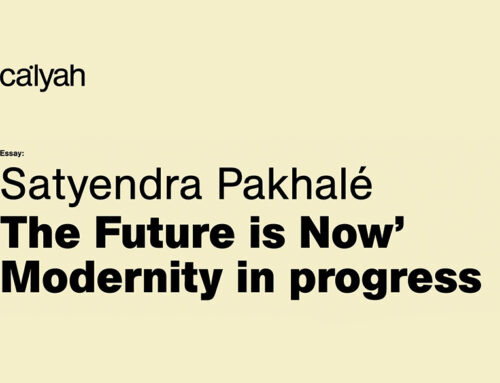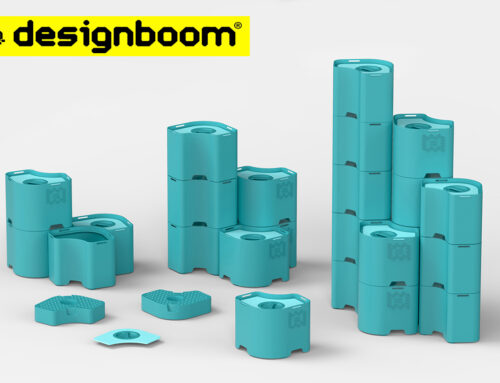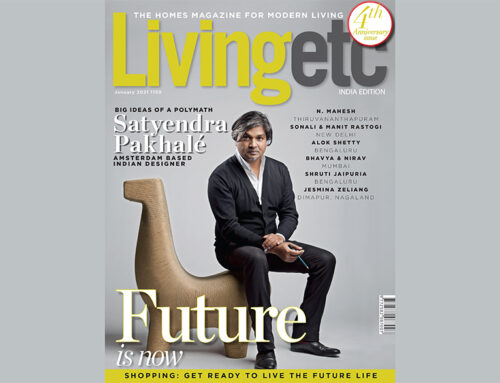Although, relatively speaking, a “young” designer – he was born in 1967 – Satyendra Pakhalé is already ranks among the world’s most influential. Top furniture houses clamour for his clever analogies, the mimicry of natural forms and the easily accessible symbolism. The appropriately titled Horse Chair is suitably equine, inviting you to saddle up and sit down; his Fish Chair swims halfway between a space ship and a child’s stick drawing. His output is emotive – all that warm ‘n fuzzy stuff that hooks straight into a human response – whilst simultaneously satisfying the desire for contemporary and sophisticated forms. This potent combination is the result of the various cultural influences that have come to bear on an industrial designer who happily straddles and combines two halves of a globe that he thinks isn’t separate at all.
Satyendra, you call yourself a “cultural nomad”. Why?
To be a nomad is to be free of any intellectual or regressive traditions or dogmas… far beyond any ism or sect… and therefore a “cultural nomad”. It’s an attitude of freedom, above all.
In my creations I always try to find that universal poetry, something that hopefully connects people from any part of the world, something like human warmth. I do not confine myself to a specific tradition, or a fixed set of ideas or notions. I feel free and would like to cherish and cultivate that freedom in my way of living and creating, by calling myself a cultural nomad.
What thinking went into the Pangea Concept car for Renault?
A lot of thinking went into conceiving a concept car that would be used for scientific explorations and environmental research expeditions. I was responsible for the interior. We conceived the car from the inside out, which is quite unique for the car industry. We also consulted scientists, who would be the end-users of such a car. Their suggestions and technological possibilities were taken into account. It was not so easy to get all those issues resolved. However, my concerns were very human in spite of the hi-tech interior.
The reason we called the car Pangea, is because the word means “one continent” in Latin, and when earth was still evolving there was more or less one continent called Pangea. It is appropriately named, as I believe we live in one world and political division of the world is regressive.
The whole point with the Pangea was to create a fully working prototype, with all of its technological features in place. It took a while to develop the kind of information and communication technologies we wanted, such as on-line navigation, 360-degree vision cameras, a tele-media camera, a graphical tablet and all the scientific gear, etc… Most of the technology we were innovating for the Pangea could almost become a reality now, after nine or so odd years. We still do not have such facilities in today’s cars. But I am sure it will happen… sooner rather than later. My only regret is that, because of the nerve-wracking deadline, I did not get to drive the finished Pangea before it was shipped to the Geneva Motor Show in Switzerland.
I am keenly interested in the technological and transportation sector and I will continue to do projects in this area. Your designs put the fun back into function. Your Fish Chair is a visual pun and extremely witty. How important is humour in your work?
I have always believed that design is a pure joy for the spectator (user) and the creator (designer). I do not have a singular or dogmatic perspective on modernity. Modernity, for me, contains all possibilities and directions and it is not stagnant or linear. Modernity is, above all, about an aware state of mind. Under the name of so-called progress we have lost the meaning of things and have made the man-made environment inhuman.
I believe a form without content is a mistake on the part of the creator. Symbolism is essential both in today’s life and in time to come. We need meanings and associations. I always work with the symbolic meaning of things and the objects I create. Fish Chair is the essence of a fish, if you like, its non-representative form. If that gives pleasure to people and make them smile then I am happy. But creating puns for the sake of a pun is never my intention. I always consider fun to be a part of function.
Playing is serious work. I always refer to my work as play. I always say I play in my studio. I play with materials. I play with manufacturing possibilities and, above all, I play with ideas and notions. I continue my romance with contemporary culture.
You are recognised as a “forward-thinking” industrial designer because of the way that you apply new materials and investigate the use of new technologies. Do you think that the future necessarily lies in new materials? Is there a Luddite bone in your body?
No, I do not have a Luddite bone in my body, I am sure about that. I do not believe in any extreme positions – intellectual or otherwise. On the one hand, I do not quite agree with the modernist and linear notion of progress, but at the same time I do not have any trouble accepting new materials and technologies. I must mention that “new for the sake of new” does not interest me at all. It should have some benefit and new possibilities, and then it turns me on.
On the other hand, new materials and technologies are still not fully acknowledged and accepted, firstly, by industries, and then secondly, by societies around the world. However, I am optimistic about the kind of innovation they bring to projects in given settings.
It is a known fact that I am keenly interested in new materials. In every project I do I always try and investigate newer technological possibilities and never consider them as a threat of any kind. But that’s not forgetting that I have also spent a considerable amount of time investigating – or playing with – ancient materials and technologies. After having worked in hi-tech industry for a while, I realised that technological products tend to lose cultural significance in their formal symbolic content, for obvious reasons. Discontented with the sterile, industrial image of most of the manufactured goods around us, I look for the warmth, the lost textures, and feelings we gain from age-old objects.
My search is for sensorial qualities in design. However, I am not nostalgic about age-old materials and processes. Opposites like new/old and ancient/contemporary somehow do not make sense to me at all. The modern and the traditional are not divorced from one another. I do not see life and culture as separate. They are one continuous, homogenous thing. I don’t think that new materials and technologies alone hold a key to the future. I think humanity holds the key to the future. I mean, an optimistic pluralistic, human future.
You completed your Mechanical Engineering/Master of Design in India and Advanced Product Design in Switzerland and now work in Holland. How do these diverse cultural influences impact on your work?
My Mechanical Engineering at university level certainly gives me a deeper insight into manufacturing, which is dear to my heart. International exposure at an early stage and first-hand experience of working with industry in advanced product design studies in Switzerland gave me a sort of world design perspective.
For any open, curious mind, diverse cultural influences are normal. It is as normal as breathing for me. However, I am also conscious of my Indian roots. Yet I do not see being “universal” at the same time as any kind of conflict. I have always believed that the more one goes deeper into one’s roots the more universal one becomes.
I have always been fascinated by how things are made, and by what kind of impact and vibe an object has had on the man-made environment. For me, design is a true blend of engineering and art. Many of my projects, such as Fish Chair, Horse Chair, Panther and Add-on Radiator, are considered to be engineered sculptures. But calling these products merely sculptures would dishonour their utilitarianism, an aspect that is very important to me. I mean, all these products work. They function very well.
Are we talking a happy marriage between East and West, here?
Well, I do not see a difference in East and West. To me, this is an old-fashioned point of view. It does not make sense at all. One can make some sort of difference in industrial societies and non-industrial societies, but that’s all. I have always seen the world as one world. I do not have any notion of a nation. It is a purely regressive and political way of dividing the beautiful, lovely Earth. The more and more I travel around the world I see that there are incredible similarities at the core of human beings. Isn’t that obvious! But somehow there is this primitive tendency to divide and rule. You may call me a dreamer, but I will continue to see the entire world as one place and it’s my playground, shall I say, my home.
Judging by your work, it’s a very fruitful intersection, and one highly relevant to the broad shifts that have resulted in today’s global culture. Your furniture and objects carry appeal for both markets. Can you comment?
I always wanted to be universal or nothing at all. Globalisation and so-called global culture is an irrelevant discussion for me. We should have talked about it a long while ago. For me what matters is humanity, in a most compassionate way. Compassion as understood in a basic Buddhist form. It has always been important to create work that makes sense to me, which appeals to me at the core, on a deep, human level. My work and personal journey – project by project – is eventually to become truly universal by truly being myself at this deep, human level.
My objects and products are a fine balance between soft and hard, between archaic and contemporary, between culture and commerce. It’s work done with a technical and cultural understanding of how things are made. Above all, it’s sensorial. It appeals to the senses and encourages people to touch and feel.
You initially worked for Phillips in the Netherlands before setting up your own studio, or atelier, in Amsterdam. Any particular affinity for Dutch design? The experimental sensibility and dry wit that runs through work by Droog or Mooi appears to have some echo in your own output. Would you agree?
I never see myself as fixed in a specific nation or cultural setting. I truly believe one must cultivate plural perspectives in any field of creation, let alone design. In today’s context, geography does not mean much and my choice to work from Amsterdam is not strategic at all.
I am humbled to have come from a long culture of object manufacture. I grew up in India surrounded by thousands of years of manufacturing history. So for me, design is an ancient and historic activity, which also makes a meaningful contribution to contemporary culture.
Everything I had as a kid, from toys to notebooks, was especially made for its purpose. I continue to live like that. I get things made for myself. I always live with prototypes, or rather, specially made things. This “culture of creation” has always been part of me. Now, I have the means and resources to continue this as a profession.
During my stay at Philips Design there was hardly any project that I worked on that was in the Netherlands. Besides, the designers at Philips were from all over the world. They came from Italy, Colombia, Sweden, the former Yugoslavia, Brazil, Switzerland, France, the USA… My interaction with manufacturing companies and designers in the Netherlands has been extremely marginal till now.
I travel a lot and have friends all over, so my cultural references in the design world are widespread. I admire the work of Luis Baragan, Issey Miyake, Shiro Kuramata, Isamu Noguchi, Buckminster Fuller, Ettore Sottsass, Frederick Kiesler and many more.
There have been two solo exhibitions of your industrial designs to date – one at the Stedelijk Museum Amsterdam and the other at the Otto Gallery Bologna in Italy. What do you think is the point of these exhibitions? While they’re great for the designer’s ego and interesting for the onlooker, surely they defeat the purpose a little? Don’t you prefer it when someone buys one of your pieces rather than merely looks at it? Or is an exhibition an industrial designer’s equivalent of a billboard?
Sorry, but seeing design purely as a commercial act of selling more things is not my understanding of the discipline. Simply because people buy more and more of my stuff does not necessarily make me happy, it’s not an ego trip of any kind. When the Stedelijk Museum Amsterdam approached me for a solo exhibition, it took me quite some time to respond to them. I had many, many questions, and many self-critical doubts. But after thinking it over, I agreed to go ahead.
Design is still a young and frail discipline. Still, in the majority of industry, they will only bring in a designer at the end of product development. I think this is an absolutely wrong understanding of the purpose of design. I am confident that, with proper understanding, design can bring a real contribution and awareness to product development. But there is a long way to go. What we need is a different way of thinking. Industrial culture based only on engineering and dogmatic ideas about modernism, needs to change. Industry needs to realise what unexpectedly innovative results one could achieve from a strategic point of view by involving a designer in the process of product development right from day one.
Unfortunately industrial design pays lip service to industry. I have seen this in various technological and automotive industries. We do not have many independent voices to show other ways of working as an industrial designer.
We need greater public awareness. We are all aware of the fact that design is a cultural act with a tremendous impact on everyday life. Exhibitions of this kind are like a dialogue, or an exchange. They are a communication platform to inform others of my way of creating and working as a designer in an industrial context and otherwise.
I think exhibitions like this definitely help to create such awareness. We need more pluralistic voices, more world perspectives, and more multi-cultural approaches in creation. That is the reason I support such activities.
The Italian show, curated by Paola Antonelli of the Museum of Modern Art New York, was titled “Satyendra Pakhalé – Design by Heart”. Do you design by heart, with heart? What is it, in terms of design principles, that you love?
My design principles are not to have any principles, to be free of all the dogmas. Yes, I do design by heart and with heart – both really. Paola called the show “Design a Memoria” – which means Design by Heart. This title really reflects her profound observation and understanding of my creative output till then.
It was not so obvious for me at the time that a lot of what I do is deeply rooted in my memories. Now, in retrospect, I do agree with Paola about my memories and influences.
However, for me design is universal poetry. Design is a political act. Design is a cultural act. But above all, design is an act of love and passion.
Is there anything that falls beyond that gamut to which you would attach the same endearing word? Life!
Read the full article on Design Indaba
